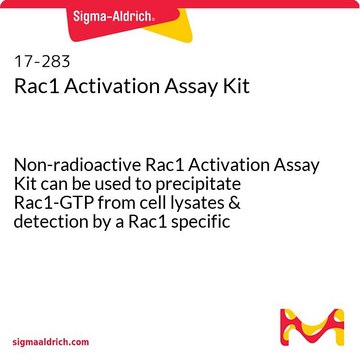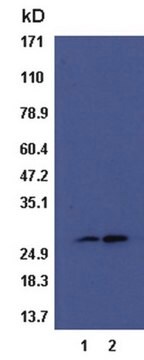추천 제품
Quality Level
종 반응성
human, mouse, rat
제조업체/상표
Upstate®
기술
activity assay: suitable
affinity binding assay: suitable (G-protein)
NCBI 수납 번호
UniProt 수납 번호
배송 상태
wet ice
유전자 정보
human ... RAC1(5879)
일반 설명
The Rac1/Cdc42 Activation Assay (Cat. No. 17-441) provides an effective method for detecting Rac and Cdc42 activity in cell lysates. This assay uses the downstream effector of Rac/Cdc42, p21-activated protein kinase (PAK1), to isolated the active GTP-bound form of Rac/Cdc42 from the sample. The p21 binding domain (PBD) of PAK1 is expressed as a GST-fusion protein and coupled to agarose beads. After precipitation, an immunoblot is performed and the activated Rac/Cdc42 is detected with specific monoclonal antibodies, followed by HRP-conjugated secondary antibody and ECL reagent.
특이성
Species Cross-reactivity: Human and mouse. Predicted to cross-react with all mammalian species.
Anti-Rac1, clone 23A8: Species Cross-reactivity: Human, mouse and rat. Other species cross-reactivity unknown.
Anti-cdc42 Species Cross-reactivity: Human, mouse, rat and dog. Other species cross-reactivity unknown.
Anti-Rac1, clone 23A8: Species Cross-reactivity: Human, mouse and rat. Other species cross-reactivity unknown.
Anti-cdc42 Species Cross-reactivity: Human, mouse, rat and dog. Other species cross-reactivity unknown.
성분
Rac/cdc42 Assay Reagent (PAK-1 PBD, agarose), Catalog # 14-325 :One vial containing 300 μg of PAK-1 PBD bound to 150 μL of glutathione agarose beads, provided as a 50% slurry in 20mM PBS, pH 7.4, containing 50% glycerol for a final volume of 300 μL.
Anti-Rac1, clone 23A8, Catalog #05-389: One vial containing 250 μg of protein G purified mouse IgG2b in 250 μL of storage buffer (0.1 M Tris-glycine, pH 7.4, 0.15 M NaCl, containing 0.05% sodium azide).
Anti-cdc42, (mouse monoclonal IgG1) , Catalog # 05-542: One vial containing 50 μg of purified mouse IgG1 in 200 μL of 50% storage buffer (20 mM sodium phosphate, pH 7.5, 150 mM NaCl, 1.5 mM sodium azide containing, 1 mg/mL BSA) and 50% glycerol.
Mg2+ Lysis/Wash Buffer, 5X, Catalog # 20-168 : Two vials, each vial containing 18 mL of 5X MLB: 125 mM HEPES, pH 7.5, 750 mM NaCl, 5% Igepal CA-630, 50 mM MgCl2, 5 mM EDTA and 10% glycerol.
100X GTPγS, 10mM, Catalog # 20-176: One vial containing 50 μL of 10 mM GTPγS, 100X stock, in 50 mM Tris-HCl, pH 7.8, non-hydrolyzable analog of GTP. Sufficient to label 5 mL of cell lysates.
100X GDP, 100mM, Catalog # 20-177: One vial containing 50 μL of 100 mM GDP, 100X stock, in 50 mM Tris-HCl, pH 7.8. GDP (Guanosine 5′-Diphosphate) for in vitro labeling of G-proteins in the inactive form. Sufficient to label 5ml of cell lysates.
Anti-Rac1, clone 23A8, Catalog #05-389: One vial containing 250 μg of protein G purified mouse IgG2b in 250 μL of storage buffer (0.1 M Tris-glycine, pH 7.4, 0.15 M NaCl, containing 0.05% sodium azide).
Anti-cdc42, (mouse monoclonal IgG1) , Catalog # 05-542: One vial containing 50 μg of purified mouse IgG1 in 200 μL of 50% storage buffer (20 mM sodium phosphate, pH 7.5, 150 mM NaCl, 1.5 mM sodium azide containing, 1 mg/mL BSA) and 50% glycerol.
Mg2+ Lysis/Wash Buffer, 5X, Catalog # 20-168 : Two vials, each vial containing 18 mL of 5X MLB: 125 mM HEPES, pH 7.5, 750 mM NaCl, 5% Igepal CA-630, 50 mM MgCl2, 5 mM EDTA and 10% glycerol.
100X GTPγS, 10mM, Catalog # 20-176: One vial containing 50 μL of 10 mM GTPγS, 100X stock, in 50 mM Tris-HCl, pH 7.8, non-hydrolyzable analog of GTP. Sufficient to label 5 mL of cell lysates.
100X GDP, 100mM, Catalog # 20-177: One vial containing 50 μL of 100 mM GDP, 100X stock, in 50 mM Tris-HCl, pH 7.8. GDP (Guanosine 5′-Diphosphate) for in vitro labeling of G-proteins in the inactive form. Sufficient to label 5ml of cell lysates.
품질
Routinely evaluated by precipitating Rac1-GTP and cdc42-GTP from 3T3/A31 and HeLa cell lysates that had been loaded with GTPγS(lysates were loaded in vitro with GTPγS for cdc42-GTP). The precipitated Rac1-GTP and cdc42-GTP was detected by immunoblot analysis using anti-Rac1 (1 μg/ml).
저장 및 안정성
1 year at -20°C from date of shipment
법적 정보
UPSTATE is a registered trademark of Merck KGaA, Darmstadt, Germany
면책조항
Unless otherwise stated in our catalog or other company documentation accompanying the product(s), our products are intended for research use only and are not to be used for any other purpose, which includes but is not limited to, unauthorized commercial uses, in vitro diagnostic uses, ex vivo or in vivo therapeutic uses or any type of consumption or application to humans or animals.
신호어
Danger
유해 및 위험 성명서
Hazard Classifications
Aquatic Acute 1 - Aquatic Chronic 2 - Eye Dam. 1
Storage Class Code
10 - Combustible liquids
시험 성적서(COA)
제품의 로트/배치 번호를 입력하여 시험 성적서(COA)을 검색하십시오. 로트 및 배치 번호는 제품 라벨에 있는 ‘로트’ 또는 ‘배치’라는 용어 뒤에서 찾을 수 있습니다.
Krishna Chinthalapudi et al.
Nature communications, 9(1), 1338-1338 (2018-04-08)
Neurofibromatosis type 2 (NF2) is a tumor-forming disease of the nervous system caused by deletion or by loss-of-function mutations in NF2, encoding the tumor suppressing protein neurofibromin 2 (also known as schwannomin or merlin). Neurofibromin 2 is a member of
Marco Trerotola et al.
Cancer research, 73(10), 3155-3167 (2013-03-29)
The molecular mechanisms underlying metastatic dissemination are still not completely understood. We have recently shown that β(1) integrin-dependent cell adhesion to fibronectin and signaling is affected by a transmembrane molecule, Trop-2, which is frequently upregulated in human carcinomas. Here, we
Mitsuyoshi Motizuki et al.
The Journal of biological chemistry, 296, 100545-100545 (2021-03-21)
Transforming growth factor-β (TGF-β) signaling promotes cancer progression. In particular, the epithelial-mesenchymal transition (EMT) induced by TGF-β is considered crucial to the malignant phenotype of cancer cells. Here, we report that the EMT-associated cellular responses induced by TGF-β are mediated
Enikő Tátrai et al.
Oncotarget, 8(27), 44498-44510 (2017-06-01)
Tumor hypoxia promotes neoangiogenesis and contributes to the radio- and chemotherapy resistant and aggressive phenotype of cancer cells. However, the migratory response of tumor cells and the role of small GTPases regulating the organization of cytoskeleton under hypoxic conditions have
Tao Dong et al.
Proceedings of the National Academy of Sciences of the United States of America, 113(27), 7644-7649 (2016-06-24)
The etiology of autism is so complicated because it involves the effects of variants of several hundred risk genes along with the contribution of environmental factors. Therefore, it has been challenging to identify the causal paths that lead to the
자사의 과학자팀은 생명 과학, 재료 과학, 화학 합성, 크로마토그래피, 분석 및 기타 많은 영역을 포함한 모든 과학 분야에 경험이 있습니다..
고객지원팀으로 연락바랍니다.









